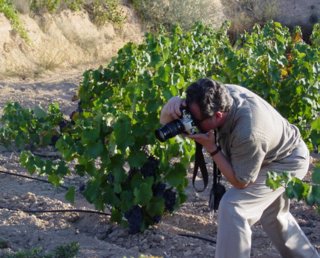La Rioja: R. López de Heredia - The Wines of Yesterday
on slideshow link to the right and go to a full screen view.
During the 1970s when I lived in southern Spain, the northern wine district of Rioja came to represent an oasis to me during the hot, rainless summers of Andalucia, my spiritual home. By early July, the heat settles in over a large portion of Spain. The sun bears down relentlessly, especially in the Mediterranean portions of the country, driving millions of Spaniards to the beaches and cool mountain resorts. Coinciding with this time of year was our annual, much anticipated trek to Pamplona, where Hemingway's inveterate lost souls come from all over the world to see the sun rise on yet another Fiesta de San Fermín, which he immortalized in The Sun Also Rises. Since my former wife Diana and I counted ourselves among the admirers of the venerable Don Ernesto's fiesta, we too joined the migration each year.
We always set out at least a week before the commencement of festivities at Pamplona, so we could explore the Spanish countryside along the way. On one of these trips, we discovered the Rioja and it became our favorite place to pass some quiet time before surrendering to the wild, week-long festivities at Pamplona, where peace, tranquillity, and sleep are rare commodities and not even particularly desirable ones at that. We looked forward to the Rioja country, where we could taste fine wines in cool bodegas, sample superb country cuisine, and enjoy the scenery, history, and milder climate of this high mountain valley.
We had arranged for two old friends, Alice Hall, the dowager empress of American bullfight aficionados of Milledgeville, Georgia and Carolyn Moyer of Davis, California to join us in a tour of the Rioja on our way to Pamplona. On this occasion, in 1973, we had written the firm of R. López de Heredia at Haro, the wine capital of La Rioja Alta, letting them know that we again wished to visit their bodega. The reply had come in the charming, graceful Spanish of a more genteel age. It went something like, "...We cannot tell you what joy the news of your imminent visit has produced in our bodega. It would be our great pleasure to receive you."
By 10:00 on the morning of our visit, after a breakfast of rolls and café con leche, the four of us were down in the bodegas of R. López de Heredia for our "second breakfast" - - a wine tasting. Here, in surroundings as incredible as any I have known in the world of wine, Sr. Anastasio Gútierrez Angulo, the firm's export manager, let us taste some of his twenty-year old reservas–wines made in the style of a different era–wines of yesterday.
Click to read the rest of La Rioja: R. López de Heredia - The Wines of Yesterday
Gerry Dawes was awarded Spain's prestigious Premio Nacional de Gastronomía (National Gastronomy Award) in 2003. He writes and speaks frequently on Spanish wine and gastronomy and leads gastronomy, wine and cultural tours to Spain. He was a finalist for the 2001 James Beard Foundation's Journalism Award for Best Magazine Writing on Wine.
Experience Spain With Gerry Dawes: Culinary Trips to Spain & Travel Consulting on Spain
Gerry Dawes can be reached at gerrydawes@aol.com; Alternate e-mail (use only if your e-mail to AOL is rejected): gerrydawes@hotmail.com
Labels: Ernest Hemingway, La Rioja, R. López de Heredia

















